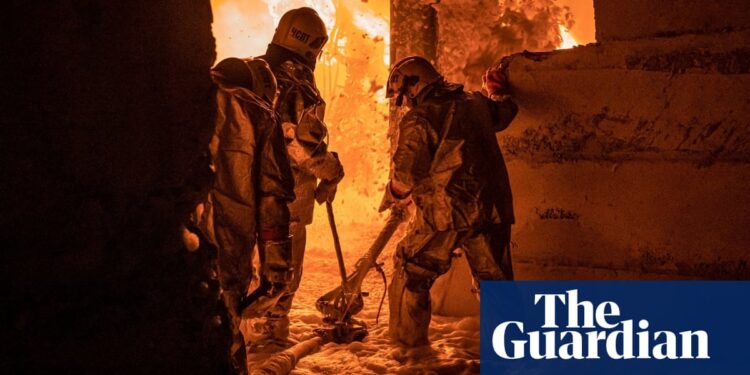Russia launched its biggest ever drone attack on Ukraine on Monday night and Tuesday morning, sending a reported 188 drones into the country against various targets, resulting in power cuts in part of western Ukraine and damage to residential buildings outside Kyiv.
Russian forces are pushing hard along the frontline in the east of the country, amid uncertainty as to how the dynamics of the war might change once Donald Trump takes office in January. Russia also vowed “retaliatory actions” for fresh Ukrainian strikes on military targets inside Russia that used long-range missiles sent by the US.
Ukraine’s air force said 76 of the drones had been shot down overnight, as air defences struggled to cope with the massed attacks that have become common in recent weeks. “Unfortunately, there were hits to critical infrastructure facilities, and private and apartment buildings were damaged in several regions due to the massive drone attack,” the air force said in a statement.
The governor of the western Ternopil region, Vyacheslav Nehoda, said on television that about 70% of the region was without power. “The consequences are bad because the facility was significantly affected and this will have impact on the power supply of the entire region for a long time,” he said. Several buildings were damaged around Kyiv, but there were no casualties reported.
Also on Tuesday, a court in the Russian city of Kursk confirmed that a British citizen had been captured and arrested by Russian authorities, the first official confirmation of news that broke over the weekend when interrogation videos appeared on Russian Telegram channels.
The court ordered that James Scott Rhys Anderson, 22, be held in custody on allegations he had “participated in armed hostilities on the territory of Kursk region”. It did not specify the exact charges, noting only that he was accused of “committing a set of particularly serious offences that post a danger to society”.
Russian military bloggers said Anderson was captured near the village of Plekhovo, taking part in Ukraine’s military offensive inside Russia, which was launched in late summer. Russian forces are now on the offensive in Kursk region, attempting to win back control of the lost territory.
In a video that surfaced over the weekend, a man in military fatigues, with his hands tied, gave his name as Anderson and said he had served in the British army between 2019 and 2023, before he was dismissed and then decided to travel to Ukraine and volunteer.
The foreign secretary, David Lammy, said on Monday he was aware of the arrest and that authorities would “offer this UK national all the support we can”.
Earlier this month, the gave Ukraine permission to strike military targets deep in Russia using US-supplied Atacms missiles, in support of its Kursk offensive. Britain followed suit, allowing the use of Storm Shadow missiles in Russia.
On Tuesday, Bloomberg reported that Britain had sent “dozens” of Storm Shadows to Ukraine recently, the first delivery since Keir Starmer took over as prime minister in July. A Ministry of Defence spokesperson declined to comment on the report. “We do not comment on operational detail, to do so would only benefit Putin,” said the spokesperson, adding that Britain’s support for Ukraine is “ironclad”.
Moscow has reacted furiously to the decision to allow strikes on targets inside Russia, with the president, Vladimir Putin, saying it amounted to a declaration of war on Russia and gave Moscow the right to strike targets in the countries that provided the weapons.
Russia’s defence ministry said Ukraine had launched further strikes using Atacms on targets include an airbase in the Kursk region and an air defence battery, causing an unspecified number of casualties and damage to equipment. It was a rare admission by Moscow of Ukrainian strikes successfully hitting their targets.
after newsletter promotion
“Retaliatory actions are being prepared,” the ministry said in a post on Telegram, without giving further detail. The first strike using Atacms led to Russia using an experimental ballistic missile against the city of Dnipro last week, and a response from Putin that hinted at nuclear options being on the table.
Both sides are seeking to position themselves before the return of Trump, who has claimed he will be able to bring a resolution to the conflict in “24 hours”, while giving few details of how he would go about it.
Allies of Ukraine are also in heated discussions about how best to keep supporting Kyiv amid a possible change in US policy. The Nato secretary general, Mark Rutte, who met Trump in Florida over the weekend, said on Tuesday that Nato allies needed to do more to help Kyiv. “Our support for Ukraine has kept them in the fight, but we need to go further to change the trajectory of the conflict,” he said during a visit to Athens.
Highlighting the importance of strengthening the bloc’s “deterrence and defence”, Rutte said it was also critical that investment and production in the arms industry was boosted.
“In pursuing its illegal war in Ukraine, Russia makes use of North Korean weapons and troops, Iranian drones and Chinese dual-use goods for its defence industry. This is a dangerous expansion of the war and a challenge to global peace and security,” he said.





